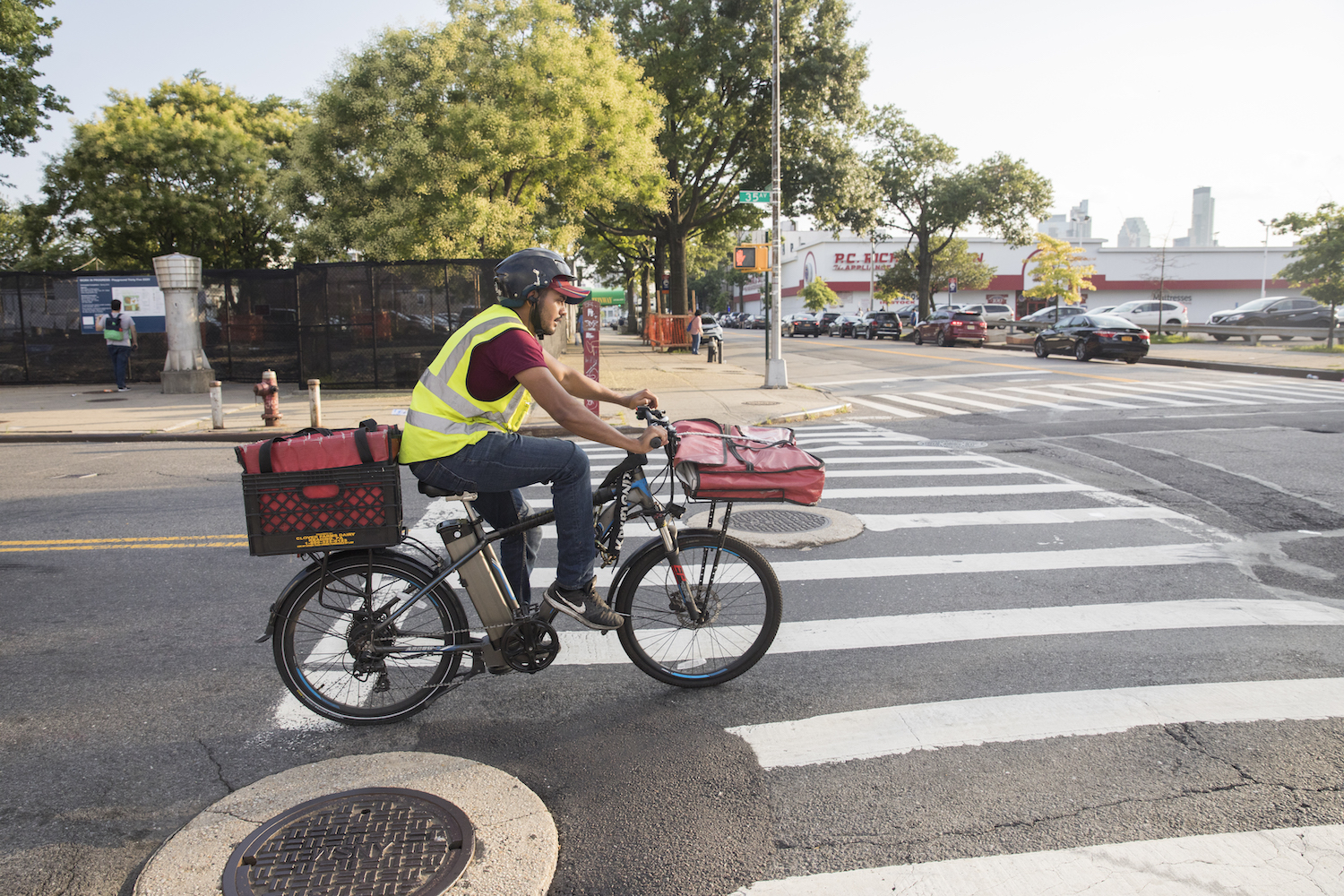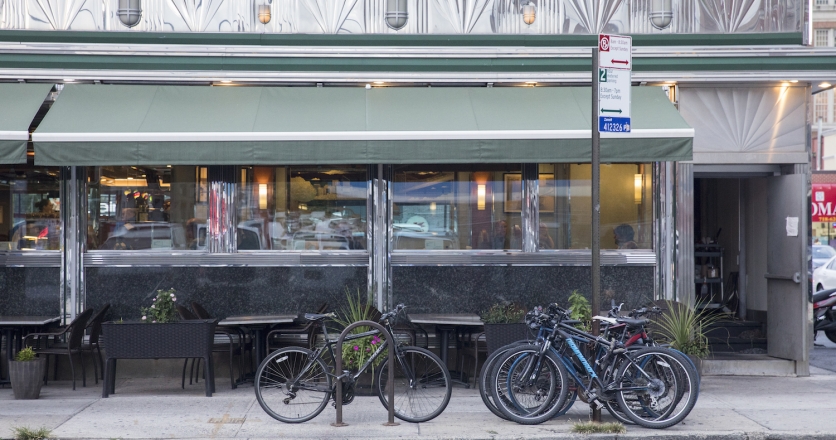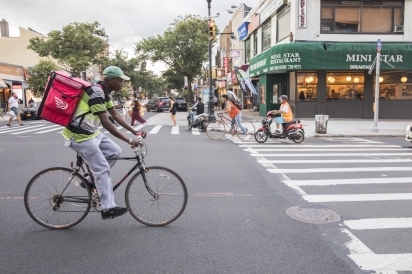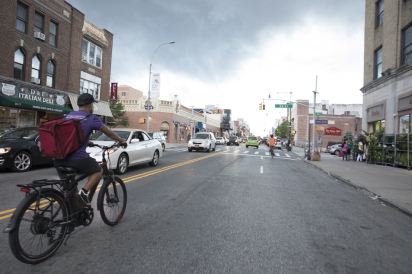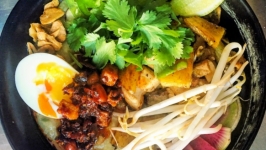Small Businesses Navigate a Restaurant Industry Dominated by Delivery Platforms
The buzzer bleats at 8:28pm. My fiancé pauses an episode of “Rick & Morty” that we have likely seen three times. I open the door to our ground-floor apartment, where a man in a rain-slicked jacket hands me a plastic bag, keeping one eye on an electric scooter parked on the sidewalk, and turns for the door before I can thank him. We take aluminum containers of chicken korma and lamb vindaloo back to the couch to eat while we watch adult cartoons. We’re not alone. Nearly two-thirds of people who order delivery in the U.S. do so at least twice a month. UBS reported that the $35 billion global online delivery market could grow to $365 billion by 2030.
In New York, four companies handle most of those deliveries: DoorDash (which owns Caviar), Uber Eats, Postmates and Grubhub (which merged with Seamless in 2013). There are over 140,000 restaurants on Grubhub, according to an October 2019 report from the platform. Fast-food and fast-casual operations use the platforms alongside local mom-and-pops. We, the food-ordering public, have choices. An abundance of them.
In November, I posed a question on Edible Queens’ Instagram Story: Would any small-business owners like to talk about how third-party delivery platforms have affected their businesses? Hands shot up, though none more quickly than @pizzasam’s, who punctuated his message with the hashtag “#F**kThirdPartyApps.”
Sam Schiralli Jr. runs Pizza Sam, the Jackson Heights restaurant his father opened in 1967, “back when restaurants were a cash cow.” Now, he says, “you’re lucky if you can pay payroll, utilities, rent and food cost and still have a few bucks left.” He was reluctant to deduct Grubhub’s commission and fees, which can total close to 33%, from his already-tight margins, but “it came down to keeping up with the Joneses. You gotta do what your neighbors are doing.”
“To be relevant in New York City, you have to be on these platforms,” agrees Serhan Ayhan, who answers my call from his office in midtown. He works in finance and spends much of his free time helping run Boston Pizza, which his family opened in Astoria in 1997. “We’re beholden to these platforms. In order to stay afloat, you have to be [on them].”
New Year’s Day is one of Pizza Sam’s biggest sales days. On January 1, 2019, Schiralli says that Grubhub did not have enough delivery workers to handle the volume, and customers were unable to place orders. When there is a shortage of drivers, Grubhub works behind the scenes to slow the pace, raising delivery minimums and fees or closing ordering in an area, depending on the case. In general, these tweaks are meant to last for 10 or so minutes. Schiralli claims customers were blocked from ordering from Pizza Sam for much of the day. Based on sales data shared with Edible Queens, Pizza Sam’s earnings dropped 68% from the previous New Year’s Day. Since skeptically signing on with the platform just a few years prior, Schiralli’s business had become dependent on it.
The next month, Pizza Sam paid $2,400 in commission and transaction fees. “I could employ someone full time with that amount of money,” says Schiralli. He decided to build his own website to field delivery orders, hoping to move away from third-party platforms. When he Googled “Pizza Sam,” his business profile’s “order now” options still linked to Grubhub and Seamless (remember, Grubhub Seamless is a single, public company), rather than his own website. He reported incorrect information, as business-owners can do if they want to change their Google profiles, a process which Schiralli claims took months. When I Googled “Pizza Sam” in November, the business profile did have a link to Schiralli’s own delivery site, preceded by an ad: “Get $12 off your 1st order” and a big red Grubhub logo. (Grubhub is, of course, free to buy ads on Google as it pleases.) The search results themselves were, in order: an ad for Caviar, Pizza Sam’s Seamless page and Pizza Sam’s own site.
On a phone call with Schiralli, he tells me, “You gotta talk to my friend.” He rests the landline on the pass. Above clattering plates, I hear Schiralli on his cell phone. “Big Rich, I’m talking to a journalist. She’s writing a story about delivery. Can I give her your number?”
Ricardo Abreu co-owns Corona Diner. He and his business partner signed on with Grubhub in 2017 at a 30% commission rate, closer to 33% after processing fees, hoping, as many do, to access the platform’s thousands of local users. At first, Corona Diner saw a boost in new business—first-time customers who discovered the restaurant on Grubhub. But Abreu claims that Grubhub’s drivers were consistently late—customers would order online and end up waiting too long for food that had been sitting around, waiting to be picked up. Abreu says, “the business took a big hit.” After all, if I, the customer, wasn’t happy with the wait for Corona Diner last time, I’ll scroll right past it the next time I’m craving disco fries.
“Many nights I’ve had to do a delivery at 3am,” Ayhan tells me over the phone. “People fall asleep and don’t answer their buzzers or their phones. I have other orders and I can’t afford to wait.” Ayhan then needs to contact Grubhub to ensure that the restaurant will receive payment for having attempted to fulfill the order, a process which can be time-consuming. And in terms of customer perception—who gets blamed for what went wrong—“My family’s restaurant gets the brunt of it.” (It is Grubhub’s policy to respond to negative reviews when they refer to something that is the platform’s responsibility, not the restaurant’s.)
“[Grubhub] looks like a positive as a small-business owner trying to bring in revenue, but in actuality, if you’re not smart about it you can easily be taken advantage [of],” says Abreu. “…You think the lifeguard is jumping in the pool to save you, and then they hand you dumbbells.” I asked Abreu if he’d ever leave the platform. He said his entire business model had shifted to depend on third-party delivery apps.
In June, The New Food Economy reported that Grubhub had registered about 23,000 web domains, all with names identical to restaurants that use the platform. The websites looked like the real deal—customers would have no idea they’re on a Grubhub-owned site—and navigated to the restaurant’s menu on Grubhub. When a customer got to that page through one of these fake sites, which often appeared higher in a Google search than a restaurant’s real website, Grubhub allegedly charged a commission in the name of “marketing.” Restaurant owners reported being unaware of websites made in their names. (Grubhub told the L.A. Times that a clause in their contracts had reserved their right to buy and operate these domains, but ultimately ended the practice earlier in 2019.) And if they wanted to start their own websites, they’d have to get creative with their domain names.
The phone number listed on a restaurant’s Grubhub or Seamless page, next to its address, is a Grubhub-owned voice-over-Internet (VOI) number. Although Grubhub’s terms reserve the company’s right to determine all “content” on a restaurant’s page, which presumably includes phone numbers, Ayhan says he noticed Boston Pizza’s VOI by chance, as did several other restaurant owners I spoke with. Calls on those numbers are routed through Grubhub and recorded, and the company earns a commission on any orders placed.
Senator Chuck Schumer called for a federal investigation into complaints that Grubhub charged restaurants for phone calls that didn’t even result in orders. In October, Mark Gjonaj was one of 30 New York City Council members who signed a letter urging Grubhub CEO Matt Maloney to refund restaurants for the phone calls in question, as well as to hire a third-party company to audit its phone orders.
On January 9, 2020, Grubhub announced revisions to its phone order policy. Gjonaj, who represents New York’s 13th district and is chairman of the Small Businesses Committee, responded with a statement:
“We appreciate Grubhub’s willingness to work with the New York City Council to address concerns about ensuring a fair playing field for local restaurants. Unfortunately, the reforms announced today are insufficient. There is nothing in the proposed changes that would make whole the thousands of restaurants that have already paid for what in many cases were erroneous phone order fees. These are hard earned dollars that could mean the difference between a restaurant staying open or having to close their doors. This is money that Grubhub was never entitled to in the first place.”
“We cannot have a sector as essential to New York’s economy [as restaurants] held hostage by four companies,” Gjonaj’s chief of staff Reginald Johnson told me over the phone. Johnson said Gjonaj’s office will likely announce a round of legislation, the first of several, in early 2020, intended to address the challenges that small businesses face with third-party delivery platforms.
So, what ever happened to a drawer full of takeout menus? “Everyone’s too lazy,” Schiralli says. But it’s more complicated than that. Grubhub’s restaurant terms read:
“Customer Data” means (i) any and all information about customers generated or collected by [Grubhub] or Restaurant through the Systems or Services, including, but not limited to, customer’s name, delivery address(es), email address(es), phone number(s), and customer preferences and tendencies and (ii) any information that may otherwise be considered “personal data” or “personal information” under applicable law. Restaurant acknowledges that all Customer Data is the sole and exclusive property of [Grubhub].”
Data is the reason that, six days after I order Indian food to eat on my couch, I get a notification. Hungry for Seva Indian Cuisine? Order now on Seamless. Data is what turns a first-time Corona Diner customer into an all-the-time Grubhub customer.
To leave the platform, a restaurant wouldn’t just have to wriggle free from Grubhub’s grip on its online presence, restructure its business model to be less dependent on delivery platforms, contend with an increasingly consolidated delivery industry and compete with their many neighbors who continue to use the platform. They’d have to win over consumers whose data and loyalty belong, more and more, to delivery services and who have been trained to value—and expect—convenience above all else.
We tap our feet impatiently when an Uber is more than a few minutes away, we’re shocked when something isn’t available via free, two-day shipping and we expect that hot, fresh takeout is a few clicks away. When we want sushi, we don’t pull out the menu for our favorite spot and call the restaurant; we type “sushi” into the Grubhub or Seamless search bar, and if our go-to is closed or has raised its delivery minimum or added a fee, it’s on to the next. We’re not (necessarily) lazy; these are just our habits. One beleaguered restaurant owner told me, anonymously, “Late at night, I order from Grubhub myself.” How can they do that?, I wonder. Then I add another order of naan to my cart and settle onto the couch, waiting, in guilt and anticipation, for the buzzer.
Pizza Sam | @pizzasam
Boston Pizza
Corona Diner


